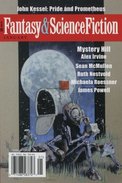
| Editor: | Gordon van Gelder |
| Issue: | Volume 114, No. 1 |
| ISSN: | 1095-8258 |
| Pages: | 162 |
This was an unusually good issue in the fiction department. There wasn't a bad story, and while there also were no standouts, the range was from enjoyable to good. The non-fiction was about average, with an extended look at the Emshwillers from James Sallis, an interesting review of Stardust (the movie version) from Kathy Maio, and a better-than-average Charles de Lint review column.
"The Twilight Year" by Sean McMullen: This semi-alternate history ends up as an Arthurian of a most unusual sort. Only the slight alternative twist puts it into the SF field; it's otherwise a light-hearted bit of historical fiction about a travelling entertainer in the final days of Roman presence in Britain. It wasn't hard to see the twist coming, but I liked where McMullen went with it, and the first-person narrator was amusing and fun. (6)
"It's a Wonderful Life" by Michaela Roessner: This is one of the better time-travel stories I've read, thanks entirely to its careful and believable introduction to the scene of the sort of character often ignored in straight science fiction. The janitor in the facility is neither a disguised genius nor the person who somehow saves the project, which I liked. The reader can never quite decide if he's onto something or if he's obsessed with the kind of idea that comes out of ignorance, or maybe a little bit of both. His idea about the best way to use a time travel device still has me thinking. (7)
"Pride and Prometheus" by John Kessel: Following the theme of alternate history, here we have alternative classics. Kessel picks up the characters from Pride and Prejudice and introduces them to Frankenstein, with amusing and oddly affecting results (as well as excellent use of Austen's trademark tone). It's a great mix and stays interesting through the whole story. (7)
"Mars: A Traveler's Guide" by Ruth Nestvold: Nestvold breaks away from the trend of alternate history and history modification and provides a straight SF story, in setting at least. The perspective and presentation, though, are highly unusual. The reader is shown only the output of an interactive help application for a Mars tourist rover. At the start, it's like reading encyclopedia entries, often interrupted by the unseen and unheard user following cross-references. But slowly, in the choice of topics and in some comments that the application can't interpret, the reader can piece together what's going on. Nestvold builds an eerie suspense through the limitations of the perspective that's highly effective by the end of the story. A gimmick story, in a sense, but very well-done. (7)
"The Quest for Creeping Charlie" by James Powell: We return to alternate history of a sort with a historical urban fantasy. George Muir becomes obsessed with discovering a mythical creature that is too smart to have ever been discovered. His search takes various amusingly self-serving and arguably lazy turns, although it finally leads to dangerous situations. The closing twist was obvious from the start, but I still smiled at it. (6)
"Mystery Hill" by Alex Irvine: The concluding story is a long tale of alien first contact against a different background: a roadside tourist attraction. The attraction itself is a hill where water runs uphill, a brilliant balance between possible con game and real physics problem that leads nicely into the meat of the story. The best part, though, is the viewpoint character, a no-nonsense veteran who is as disgusted with the true believers who frequent his attraction as he is with the local teenagers who insist on dancing on his miniature golf course. I could have done with less of the crazy local hillbilly, but the characters are otherwise excellent and the off-beat romance angle worked. No deep philosophy here, but a lot of solid entertainment. (7)
Reviewed: 2008-02-25